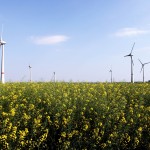Wind turbine noise has hit the headlines recently, but the issues aren’t as clear-cut as some media say. We spoke to Dr. Jeremy Bass, Senior Technical Manager at RES, to uncover a few technical details…
How would you describe the noise a wind turbine makes?
It depends on where you stand and listen!
A typical modern wind turbine, at source, produces noise which is dominated by broadband aerodynamic noise from the blades, and this typically has a noise emission spectrum similar to a ‘hushing’ sound.
In the near field of the turbine, i.e. within a horizontal distance from the tower similar to that of the turbines’ tip height (~ 100 m), this aerodynamic noise is typically modulated, i.e. it varies in level, at the blade passing frequency, which is three times the rotational speed of the rotor, around 1 Hz for a modern wind turbine. Tonal noise may also be audible in the near-field, emanating from the gearbox, generator and associated cooling fans.
In the far-field of the turbines, i.e. at typical residential distances (~ 1000 m), the noise is rather different, and noise levels are lower, typically close to background noise levels. No modulation is typically apparent, nor is any tonal noise. Turbine noise is rarely a dominant component of the ambient noise at residences and noise from external sources, for example, road traffic, aeroplanes, farm machinery etc generally obscure it.
How do turbines made today compare to those made 10 years ago? What technological developments have taken place?
Many technological developments have taken place over this period, but in the context of noise one significant development is that 10 years ago it was common for turbines to operate at a fixed speed, or perhaps at one of two fixed speeds, depending on the strength of the wind. These days nearly all turbines are fully variable in speed, which means they are able to operate at the most efficient rotational speed in all winds. The result of this is a low speed of rotation in light winds, resulting in very low levels of noise emission, much lower than was previously possible.
The other obvious change is that turbines have got much bigger in the last 10 years, from turbines with sub-megawatt ratings and rotor diameters of around 50 m, to much larger machines with multi-megawatt ratings and rotor diameters of 100 m plus. This brings economies of scale, with fewer turbines on a given site required for the same overall capacity. In terms of overall level of noise at far-field sites, this change has had almost no effect, as whilst the individual turbines create slightly more noise than previously, less are required for a given site and the distances from turbines to nearest residential properties has increased accordingly.
How big is the noise challenge for wind farm designers? How big a factor is noise when it comes to public support?
Wind farm design, from a noise perspective, is something developers pay close attention to, as they all want their projects to be ‘good neighbours’ to those living locally and to avoid any noise-related disturbance. There are a number of challenges which they face to achieve this:
• getting good acoustic data from the manufacturers fully describing the noise emission of their turbines in the conditions prevailing on site,
• getting appropriate warranties from the manufacturers guaranteeing that these levels will not be exceeded,
• obtaining a detailed knowledge of the locations of local residences through a site survey,
• performing a background noise survey, at least in the UK, at a representative sample of local residences for a long enough period to completely capture the existing noise character of the site. This generally means 3 – 5 sound level meters on site for a period of 1 – 2 months
• using this information to determine appropriate noise limits for local residences
• given the above, and a detailed knowledge of the local topography and meteorology, predicting noise emission levels at local residences and ensuring that these comply with the appropriate noise limits,
• presenting all this information to the relevant permitting agency and persuading them that the analysis has been done in a competent matter and accurately reflects reality,
• agreeing appropriate noise controls for the project with the planning authority specifying precisely what local householders can expect at their residences as a maximum, in terms of noise.
In terms of public support, noise is often a significant, if not the most significant, factor. This is particularly true in the UK, which is a small, highly populated, island with relatively few areas of uninhabited land. The best way this can be addressed is by providing free access to as much information about wind turbine noise as possible, whether through documentation, e.g. environmental impact assessments, or directly, e.g. through public meetings and exhibitions. A significant hurdle these days are highly organised opposition groups, particularly those who, by spreading misinformation, can create real apprehension in local residents. Again, freely providing as much information as possible is the best approach to such activities.
All these questions and more will be addressed at the EWEA Noise Workshop in Oxford, on 11 – 12 December 2012. If you are interested visit the website for the event and consider registering for it.
By Zoë Casey, http://www.ewea.org/blog



